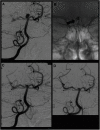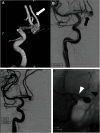Intraaneurysmal Neck Plasty: Efficacy of a Super Compliant Double-Lumen Balloon Microcatheter
- PMID: 37501900
- PMCID: PMC10370973
- DOI: 10.5797/jnet.oa.2020-0148
Intraaneurysmal Neck Plasty: Efficacy of a Super Compliant Double-Lumen Balloon Microcatheter
Abstract
Objective: While wide-neck aneurysms can be treated with several methods, we report the specific technique of intraaneurysmal neck plasty (IANP) with a super compliant double-lumen balloon microcatheter (Super-Masamune).
Methods: The Super-Masamune was inflated inside 18 aneurysms. Cases in which the tip of the Super-Masamune was located in the aneurysm were included. Embolization methods were the same as those used in the application of other balloons/stents. The use of the Super-Masamune for the performance of IANP followed two patterns: (1) the Super-Masamune was used not only as a balloon but also for coil insertion (simple IANP); (2) the Super-Masamune was used only as a balloon, and a microcatheter for coil insertion was separately introduced coaxially (coaxial IANP).
Results: The aneurysms were located in the anterior communicating artery (n = 6), middle cerebral artery (MCA; n = 4), anterior cerebral artery (n = 1), internal carotid artery (n = 5), basilar artery (n = 1), and vertebral artery (n = 1). Eight of the aneurysms were ruptured, while 10 were unruptured. Simple and coaxial IANP were both performed in seven cases. Embolization was not performed after inflating the Super-Masamune inside the aneurysm in four cases. Embolization grades following the procedure included eight neck remnants (NRs) and six body fillings (BFs). There was one complication of intraoperative rerupture; however, there was no rupture/rerupture in the follow-up period. Retreatment of the target aneurysm was performed in two cases. The embolization grade assessed in the follow-up period reached complete occlusion for one patient, NR for five, and BF for two patients.
Conclusion: IANP using the Super-Masamune is useful for the treatment of wide-neck aneurysms in which the introduction of a guidewire and/or microcatheter into the branching artery is difficult.
Keywords: balloon assist; embolization; intraaneurysmal neck plasty.
©2021 The Japanese Society for Neuroendovascular Therapy.
Conflict of interest statement
We declare no conflicts of interest.
Figures





Similar articles
-
Preservation of Branching Vessel Using Super Compliant Double-Lumen Balloon Microcatheter: Bulging Neck Plasty Technique and Other Options.J Neuroendovasc Ther. 2021;15(5):310-315. doi: 10.5797/jnet.oa.2020-0152. Epub 2020 Dec 29. J Neuroendovasc Ther. 2021. PMID: 37501908 Free PMC article.
-
Modified balloon assisted coil embolization for the treatment of intracranial and cervical arterial aneurysms using coaxial dual lumen balloon microcatheters: initial experience.J Neurointerv Surg. 2014 Nov;6(9):704-7. doi: 10.1136/neurintsurg-2013-010936. Epub 2013 Oct 23. J Neurointerv Surg. 2014. PMID: 24153339
-
Initial experience with the new double-lumen scepter balloon catheter for treatment of wide-necked aneurysms.Korean J Radiol. 2013 Sep-Oct;14(5):832-40. doi: 10.3348/kjr.2013.14.5.832. Epub 2013 Aug 30. Korean J Radiol. 2013. PMID: 24043982 Free PMC article.
-
Usefulness of the Double-Lumen Super-Compliant Balloon Catheter "Super-Masamune" for Balloon-Assisted Coil Embolization of Carotid-Cavernous Fistulas.J Neuroendovasc Ther. 2021;15(9):615-620. doi: 10.5797/jnet.cr.2020-0110. Epub 2021 Jan 20. J Neuroendovasc Ther. 2021. PMID: 37501750 Free PMC article.
-
[Coil Embolization for Very Small Intracranial Aneurysms with Diameter Less than 3mm:A Case Series of 14 Patients and Literature Review].No Shinkei Geka. 2018 Apr;46(4):303-312. doi: 10.11477/mf.1436203721. No Shinkei Geka. 2018. PMID: 29686163 Review. Japanese.
Cited by
-
Endovascular Treatment of Wide-Neck Bifurcation Aneurysm: Recent Trends in Coil Embolization with Adjunctive Technique.J Neuroendovasc Ther. 2024;18(3):75-83. doi: 10.5797/jnet.ra.2023-0072. Epub 2024 Jan 13. J Neuroendovasc Ther. 2024. PMID: 38559450 Free PMC article. Review.
-
Preservation of Branching Vessel Using Super Compliant Double-Lumen Balloon Microcatheter: Bulging Neck Plasty Technique and Other Options.J Neuroendovasc Ther. 2021;15(5):310-315. doi: 10.5797/jnet.oa.2020-0152. Epub 2020 Dec 29. J Neuroendovasc Ther. 2021. PMID: 37501908 Free PMC article.
References
-
- Guglielmi G, Viñuela F, Dion J, et al. : Electrothrombosis of saccular aneurysms via endovascular approach. Part 2: Preliminary clinical experience. J Neurosurg 1991; 75: 8–14. - PubMed
-
- Ezura M, Kimura N, Uenohara H: Super-Masamune: developing process and animal study. JNET J Neuroendovasc Ther 2015; 9: 187–191. (in Japanese)
-
- Ezura M, Kimura N, Uenohara H: Super-Masamune: initial clinical experience. JNET J Neuroendovasc Ther 2015; 9: 192–196. (in Japanese)
-
- Takahashi A, Ezura M, Yoshimoto T: Broad neck basilar tip aneurysm treated by neck plastic intra-aneurysmal GDC embolisation with protective balloon. Interv Neuroradiol 1997; 3: 167–170. - PubMed
LinkOut - more resources
Full Text Sources
Miscellaneous

